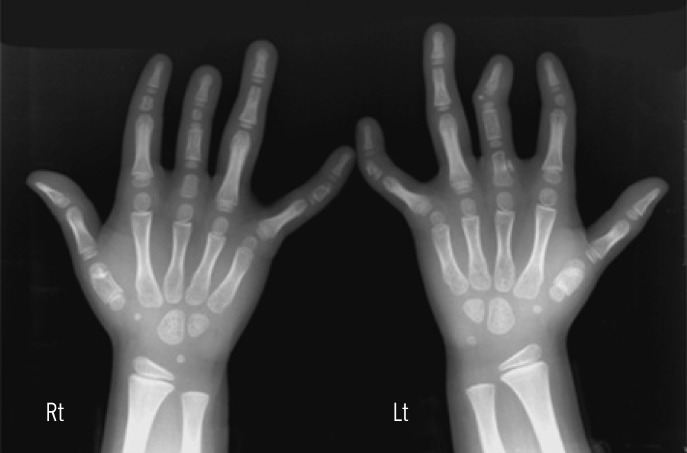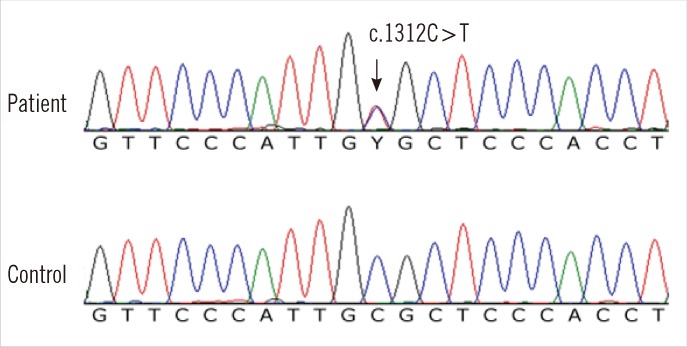Abstract
Brachydactyly type C (BDC) is characterized by shortening of the middle phalanges of the index, middle, and little fingers. Hyperphalangy of the index and middle finger and shortening of the first metacarpal can also be observed. BDC is a rare genetic condition associated with the GDF5 gene, and this condition has not been confirmed by genetic analysis so far in the Korean population. Herein, we present a case of a 6-yr-old girl diagnosed with BDC confirmed by molecular genetic analysis. The patient presented with shortening of the second and third digits of both hands. Sequence analysis of the GDF5 gene was performed and the pathogenic mutation, c.1312C>T (p.Arg438Cys), was identified. Interestingly, this mutation was previously described in a patient who presented with the absence of the middle phalanges in the second through fifth toes. However, our patient showed no involvement of the feet. Considering intrafamilial and interfamilial variability, molecular analysis of isolated brachydactyly is warranted to elucidate the genetic origin and establish a diagnosis.
Brachydactyly is a condition that results in the shortening of digits due to an abnormal development of the phalanges, metacarpals, or both [1]. Brachydactyly may present as an isolated feature or as a part of a complex malformation syndrome. Isolated brachydactyly can be classified into 5 types on the basis of anatomy and genetics. Brachydactyly type A can be further classified into 5 subtypes. Brachydactyly type C (BDC) is characterized by the shortening of the middle phalanges of the index, middle, and little fingers. Hyperphalangy of the index and middle fingers can also be observed and is associated with the shortening of the first metacarpal. Usually, in BDC, the ring finger appears unaffected and is the longest digit in affected patients.
Growth differentiation factor-5 (GDF5) gene, also known as cartilage-derived morphogenetic protein-1 (CDMP1), is the only gene known to be associated with BDC. BDC is associated with multiple inherited genotypes of the GDF5 gene including autosomal dominant, autosomal recessive, and even a semidominant pattern of inheritance has been reported [2]. Mutations in the GDF5 gene also result in recessive acromesomelic dysplasias of Hunter-Thompson type, Grebe type chondrodysplasia, and Du Pan syndrome, characterized by short stature, severe limb shortening, and profound brachydactyly [3]. Moreover, phenotypic variability is a typical hallmark of BDC, and variation is found in individuals of the same family harboring identical mutations [4]. Therefore, elucidating the genetic origin and establishing a genetic diagnosis are important for understanding the role of GDF5 gene in cartilage and bone formation and the molecular pathogenesis of isolated brachydactyly.
Although the incidence and prevalence have not been well established, isolated brachydactyly is expected to be rare in the Korean population [5]. To the best of our knowledge, no BDC case has been confirmed by molecular genetic analysis in this population. Herein, we report the GDF5 mutation identified in a Korean BDC patient with relevant clinical findings.
A 6-yr-old girl presenting with shortening of the second and third digits on both hands was admitted for evaluation. She had normal stature and development compared to the general Korean standards. She had normal prenatal and birth history as well as no family history of shortened digits. Hand examination revealed that the first, second, and third digits were short. The fourth digit was the longest and appeared normal. The distal phalanx of the left second digit was deviated to the ulnar side and that of the left third digit was deviated to the radial side. Mild clinodactyly was present in the fifth digit of both hands. Range of motion of individual joints was normal and her feet were unaffected. She had no other skeletal or non-skeletal dysmorphisms. Radiographs showed shortening of the thumb metacarpals and middle phalanges of the second, third, and fifth digits (Fig. 1).
Informed consent was obtained and whole blood was collected from the patient in EDTA blood collection tubes. DNA was extracted and PCR was performed using primers specific for 2 coding exons (data not shown). The amplified products were sequenced on an ABI 3730 analyzer (Applied Biosystems, Foster City, CA, USA) using a BigDye Terminator v3.1 Cycle sequencing kit (Applied Biosystems,) (Reference cDNA sequence: NM_000557.2). Sequence analysis of GDF5 revealed a missense mutation at c.1312C>T that resulted in a change in the protein level of p.Arg438Cys (Fig. 2). Mutation analysis and clinical review of this patient were approved by the institutional review board of Inje University, Sanggye Paik Hospital.
This is the first genetically confirmed case of isolated brachydactyly in the Korean population. Isolated brachydactyly, including BDC, is a clinically and genetically heterogeneous disorder. In addition to the characteristic features of brachydactyly, BDC patients may have ulnar deviation of the index finger as well as hypersegmentation of the proximal or middle phalanges [6]. Interestingly, the first case report characterizing BDC with the same mutation identified in this study, described that the patient had no middle phalanges in their second through fifth toes [7]. Our patient showed no involvement of the feet. These findings suggest that this disorder may vary in its phenotype even within individuals with the exact same gene mutation. Concerning intrafamilial and interfamilial phenotypic variability, different genetic background and/or environmental factors associated with each patient are suggested to be involved in the pathogenesis [2].
The GDF5 gene may be associated with various types of disorders including BDC. Among the 34 known mutations of the GDF5 gene listed in the Human Gene Mutation Database (http://www.hgmd.cf.ac.uk/ac/gene.php?gene=GDF5), only 15 are known to cause BDC [2, 6-9]. In addition to BDC, other disorders such as brachydactyly type A2, Du Pan syndrome, Grebe type chondrodysplasia, Hunter-Thompson type acromesomelic dysplasia, multiple synostoses, and proximal symphalangism are also associated with GDF5 gene abnormalities. Interestingly, while some mutations that decrease GDF5 expression seem to be the main basis for the development of brachydactyly, other mutations that increase the activity of GDF5 result in proximal symphalangism [10]. In a recent study, a novel missense mutation in GDF5 was shown to cause brachydactyly type A1 [11]. Furthermore, some heterozygous mutation carriers of GDF5 showed phenotypes similar to brachydactyly type E [2]. Therefore, molecular characterization of the GDF5 gene will be helpful to diagnose and reclassify isolated brachydactyly on the basis of genetic background rather than clinical phenotype. These findings will also help in understanding the role of GDF5 in normal cartilage and bone development.
References
2. Schwabe GC, Türkmen S, Leschik G, Palanduz S, Stöver B, Goecke TO, et al. Brachydactyly type C caused by a homozygous missense mutation in the prodomain of CDMP1. Am J Med Genet A. 2004; 124A:356–363. PMID: 14735582.

3. Seemann P, Schwappacher R, Kjaer KW, Krakow D, Lehmann K, Dawson K, et al. Activating and deactivating mutations in the receptor interaction site of GDF5 cause symphalangism or brachydactyly type A2. J Clin Invest. 2005; 115:2373–2381. PMID: 16127465.

4. Savarirayan R, White SM, Goodman FR, Graham JM Jr, Delatycki MB, Lachman RS, et al. Broad phenotypic spectrum caused by an identical heterozygous CDMP-1 mutation in three unrelated families. Am J Med Genet A. 2003; 117A:136–142. PMID: 12567410.

5. Baek GH, Chung MS, Park YB, Yoo KH. The relative incidence of congenital anomalies of the hand. J Korean Orthop Assoc. 1997; 32:796–801.

6. Everman DB, Bartels CF, Yang Y, Yanamandra N, Goodman FR, Mendoza-Londono JR, et al. The mutational spectrum of brachydactyly type C. Am J Med Genet. 2002; 112:291–296. PMID: 12357473.

7. Polinkovsky A, Robin NH, Thomas JT, Irons M, Lynn A, Goodman FR, et al. Mutations in CDMP1 cause autosomal dominant brachydactyly type C. Nat Genet. 1997; 17:18–19. PMID: 9288091.

8. Holder-Espinasse M, Escande F, Mayrargue E, Dieux-Coeslier A, Fron D, Doual-Bisser A, et al. Angel shaped phalangeal dysplasia, hip dysplasia, and positional teeth abnormalities are part of the brachydactyly C spectrum associated with CDMP-1 mutations. J Med Genet. 2004; 41:e78. PMID: 15173244.

9. Yang W, Cao L, Liu W, Jiang L, Sun M, Zhang D, et al. Novel point mutations in GDF5 associated with two distinct limb malformations in Chinese: brachydactyly type C and proximal symphalangism. J Hum Genet. 2008; 53:368–374. PMID: 18283415.

10. Dawson K, Seeman P, Sebald E, King L, Edwards M, Williams J 3rd, et al. GDF5 is a second locus for multiple-synostosis syndrome. Am J Hum Genet. 2006; 78:708–712. PMID: 16532400.

11. Byrnes AM, Racacho L, Nikkel SM, Xiao F, MacDonald H, Underhill TM, et al. Mutations in GDF5 presenting as semidominant brachydactyly A1. Hum Mutat. 2010; 31:1155–1162. PMID: 20683927.

Fig. 1
Radiographic findings of both hands at age 5 yr and 7 months. The bilateral short first metacarpals show large pseudoepiphyses. The middle phalanges of the second, third, and fifth fingers are short, with clinodactyly of the fifth fingers. The fourth fingers are unaffected. The proximal phalanges of both third fingers are short. Note the segmentation anomaly with accessory ossification along the proximal phalanx and an accessory ivory dense epiphysis at the base of the distal phalanx of the left third finger. Note the ulnar deviation of the left second finger and radial curvature of the third finger. The carpal bone age is retarded.
Abbreviations: Rt, right; Lt, left.





 PDF
PDF ePub
ePub Citation
Citation Print
Print



 XML Download
XML Download